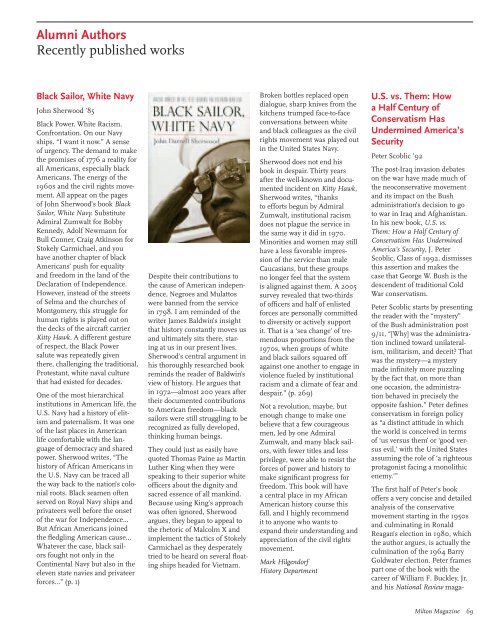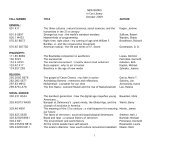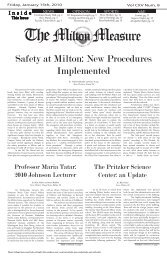Milton Magazine - Milton Academy
Milton Magazine - Milton Academy
Milton Magazine - Milton Academy
- No tags were found...
You also want an ePaper? Increase the reach of your titles
YUMPU automatically turns print PDFs into web optimized ePapers that Google loves.
Alumni AuthorsRecently published worksBlack Sailor, White NavyJohn Sherwood ’85Black Power. White Racism.Confrontation. On our Navyships. “I want it now.” A senseof urgency. The demand to makethe promises of 1776 a reality forall Americans, especially blackAmericans. The energy of the1960s and the civil rights movement.All appear on the pagesof John Sherwood’s book BlackSailor, White Navy. SubstituteAdmiral Zumwalt for BobbyKennedy, Adolf Newmann forBull Conner, Craig Atkinson forStokely Carmichael, and youhave another chapter of blackAmericans’ push for equalityand freedom in the land of theDeclaration of Independence.However, instead of the streetsof Selma and the churches ofMontgomery, this struggle forhuman rights is played out onthe decks of the aircraft carrierKitty Hawk. A different gestureof respect, the Black Powersalute was repeatedly giventhere, challenging the traditional,Protestant, white naval culturethat had existed for decades.One of the most hierarchicalinstitutions in American life, theU.S. Navy had a history of elitismand paternalism. It was oneof the last places in Americanlife comfortable with the languageof democracy and sharedpower. Sherwood writes, “Thehistory of African Americans inthe U.S. Navy can be traced allthe way back to the nation’s colonialroots. Black seamen oftenserved on Royal Navy ships andprivateers well before the onsetof the war for Independence...But African Americans joinedthe fledgling American cause...Whatever the case, black sailorsfought not only in theContinental Navy but also in theeleven state navies and privateerforces...” (p. 1)Despite their contributions tothe cause of American independence,Negroes and Mulattoswere banned from the servicein 1798. I am reminded of thewriter James Baldwin’s insightthat history constantly moves usand ultimately sits there, staringat us in our present lives.Sherwood’s central argument inhis thoroughly researched bookreminds the reader of Baldwin’sview of history. He argues thatin 1972—almost 200 years aftertheir documented contributionsto American freedom—blacksailors were still struggling to berecognized as fully developed,thinking human beings.They could just as easily havequoted Thomas Paine as MartinLuther King when they werespeaking to their superior whiteofficers about the dignity andsacred essence of all mankind.Because using King’s approachwas often ignored, Sherwoodargues, they began to appeal tothe rhetoric of Malcolm X andimplement the tactics of StokelyCarmichael as they desperatelytried to be heard on several floatingships headed for Vietnam.Broken bottles replaced opendialogue, sharp knives from thekitchens trumped face-to-faceconversations between whiteand black colleagues as the civilrights movement was played outin the United States Navy.Sherwood does not end hisbook in despair. Thirty yearsafter the well-known and documentedincident on Kitty Hawk,Sherwood writes, “thanksto efforts begun by AdmiralZumwalt, institutional racismdoes not plague the service inthe same way it did in 1970.Minorities and women may stillhave a less favorable impressionof the service than maleCaucasians, but these groupsno longer feel that the systemis aligned against them. A 2005survey revealed that two-thirdsof officers and half of enlistedforces are personally committedto diversity or actively supportit. That is a ‘sea change’ of tremendousproportions from the1970s, when groups of whiteand black sailors squared offagainst one another to engage inviolence fueled by institutionalracism and a climate of fear anddespair.” (p. 269)Not a revolution, maybe, butenough change to make onebelieve that a few courageousmen, led by one AdmiralZumwalt, and many black sailors,with fewer titles and lessprivilege, were able to resist theforces of power and history tomake significant progress forfreedom. This book will havea central place in my AfricanAmerican history course thisfall, and I highly recommendit to anyone who wants toexpand their understanding andappreciation of the civil rightsmovement.Mark HilgendorfHistory DepartmentU.S. vs. Them: Howa Half Century ofConservatism HasUndermined America’sSecurityPeter Scoblic ’92The post-Iraq invasion debateson the war have made much ofthe neoconservative movementand its impact on the Bushadministration’s decision to goto war in Iraq and Afghanistan.In his new book, U.S. vs.Them: How a Half Century ofConservatism Has UnderminedAmerica’s Security, J. PeterScoblic, Class of 1992, dismissesthis assertion and makes thecase that George W. Bush is thedescendent of traditional ColdWar conservatism.Peter Scoblic starts by presentingthe reader with the “mystery”of the Bush administration post9/11, “[Why] was the administrationinclined toward unilateralism,militarism, and deceit? Thatwas the mystery—a mysterymade infinitely more puzzlingby the fact that, on more thanone occasion, the administrationbehaved in precisely theopposite fashion.” Peter definesconservatism in foreign policyas “a distinct attitude in whichthe world is conceived in termsof ‘us versus them’ or ‘good versusevil,’ with the United Statesassuming the role of ‘a righteousprotagonist facing a monolithicenemy.’”The first half of Peter’s bookoffers a very concise and detailedanalysis of the conservativemovement starting in the 1950sand culminating in RonaldReagan’s election in 1980, whichthe author argues, is actually theculmination of the 1964 BarryGoldwater election. Peter framespart one of the book with thecareer of William F. Buckley, Jr.and his National Review maga-<strong>Milton</strong> <strong>Magazine</strong> 69
















